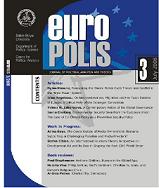On Neo-medievalism, Migration and the Fuzzy Borders of Europe: A Critical View of the Schengen Convention
On Neo-medievalism, Migration and the Fuzzy Borders of Europe: A Critical View of the Schengen Convention
Author(s): Irina AngelescuSubject(s): Politics / Political Sciences
Published by: Centrul de Analiza Politica
Summary/Abstract: After the Cold War, debates surrounding the nature of the European Union became stringent. Explanatory theories presented the EU as either a postmodern, unique project, or as a (federal) state in formation. The present paper will focus on a third alternative: neo-medievalism. Neo-medievalism draws its analogy from the past and refers to “a system of overlapping authority and multiple loyalties, held together by a duality of competing universalistic claims” (Friedrichs 2001, 475). The present paper will make a critical analysis of the Schengen Convention in order to validate the neo-medieval paradigm. The provisions of Schengen illustrate not only the fuzzy nature of the European borders, also the ‘pooled sovereignty’ and core-periphery pattern that characterize the European migration control policy-making, all of which are encoded in the neo-medieval paradigm. The paper argues that the changes brought about by the Treaty of Lisbon come to enhance the neo-medieval characteristics and indicate a need to rethink the nature of the European project.
Journal: Europolis, Journal Of Political Science And Theory
- Issue Year: 2/2008
- Issue No: 01 (3)
- Page Range: 45-64
- Page Count: 19

